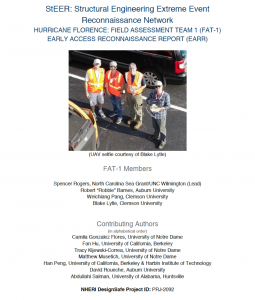StEER is pleased to release its “Hurricane Florence: Field Assessment Team 1 (FAT-1) Early Access Reconnaissance Report (EARR).
The report is being curated in DesignSafe (DOI available shortly):
https://www.designsafe-ci.org/
The report is intended for use by those planning potential follow up damage investigations for Hurricane Florence. The report will also have value to communities affected by the storm in assessing the damage and current state of infrastructure, as they begin the repair and build process.
GEER and StEER FAT-2 are currently on the ground in North Carolina collecting additional data this week. Please stay tuned to the Florence Slack channel for updates.
About StEER
The National Science Foundation (NSF) awarded a 2-year EAGER grant (CMMI 1841667) to a consortium of universities to form the Structural Extreme Events Reconnaissance (StEER) Network. StEER’s mission is to deepen the structural natural hazards engineering (NHE) community’s capacity for reliable post-event reconnaissance by: (1) promoting community-driven standards, best practices, and training for RAPID field work; (2) coordinating official event responses in collaboration with other stakeholders and reconnaissance groups; and (3) representing structural engineering within the wider extreme events reconnaissance (EER) consortium in geotechnical engineering (GEER) and social sciences (SSEER) to foster greater potentials for truly interdisciplinary reconnaissance. StEER also works closely with the NSF-supported Natural Hazards Engineering Research Infrastructure (NHERI) RAPID facility and cyberinfrastructure Reconnaissance Portal to more effectively leverage these resources to benefit StEER missions.
StEER’s Organizational Structure
StEER’s founding organizational structure includes a governance layer comprised of core leadership with Associate Directors for each of the primary hazards as well as cross-cutting areas of Assessment Technologies and Data Standards, led by the following individuals:
-
Tracy Kijewski-Correa (PI), University of Notre Dame, serves as StEER Director responsible with overseeing the design and operationalization of the network.
-
Khalid Mosalam (co-PI), University of California, Berkeley, serves as StEER Associate Director for Seismic Hazards, leading StEER’s Pacific Regional node and serving as primary liaison to the Earthquake Engineering community.
-
David O. Prevatt (co-PI), University of Florida, serves as StEER Associate Director for Wind Hazards, leading StEER’s Atlantic/Gulf Regional node and serving as primary liaison to the Wind Engineering community.
-
Ian Robertson (co-PI), University of Hawai’i at Manoa, serves as StEER Associate Director for Assessment Technologies, guiding StEER’s development of a robust approach to damage assessment across the hazards.
-
David Roueche (co-PI), Auburn University, serves as StEER Associate Director for Data Standards, ensuring StEER processes deliver reliable and standardized reconnaissance data.










